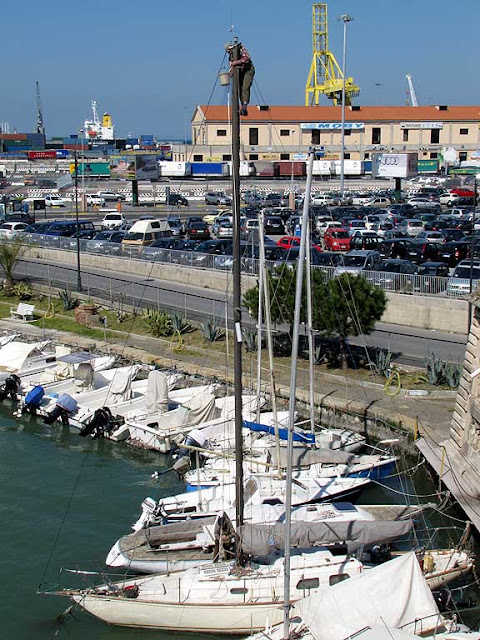 Last Thursday, lunch hour.
Last Thursday, lunch hour.Thursday, March 31, 2011
Wednesday, March 30, 2011
Tuesday, March 29, 2011
Stone, Bronze and Iron
 The statue of “Vittorio Emanuele II” by Augusto Rivalta.
The statue of “Vittorio Emanuele II” by Augusto Rivalta. Quite elaborate ironwork on a fanlight window.
Quite elaborate ironwork on a fanlight window. Portrait of a sea monster, part of the fountains by Pietro Tacca.
Portrait of a sea monster, part of the fountains by Pietro Tacca. The terrace above the loggia of “Palazzo San Sebastiano”.
The terrace above the loggia of “Palazzo San Sebastiano”.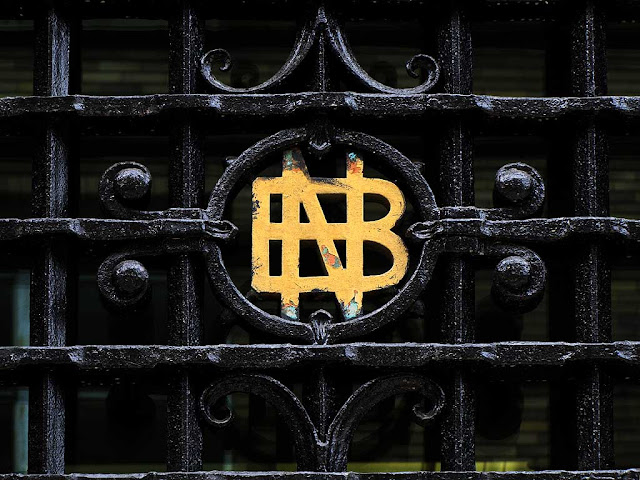 Window grate with the monogram of the former “Banco di Napoli” in “Via Cairoli”.
Window grate with the monogram of the former “Banco di Napoli” in “Via Cairoli”.More Walks
Monday, March 28, 2011
Urania, Chimera and Sirio
 In this period of the year a group of ships of the Italian Navy visits the port of Livorno as part of a training cruise for young officers. Here are the corvettes “Urania” (F 552) and “Chimera” (F 556).
In this period of the year a group of ships of the Italian Navy visits the port of Livorno as part of a training cruise for young officers. Here are the corvettes “Urania” (F 552) and “Chimera” (F 556). This class of units was developed in the 1980s and 1990s with the purpose of patrolling coastal waters, policing the fishing areas and is often used to train naval commandos.
This class of units was developed in the 1980s and 1990s with the purpose of patrolling coastal waters, policing the fishing areas and is often used to train naval commandos.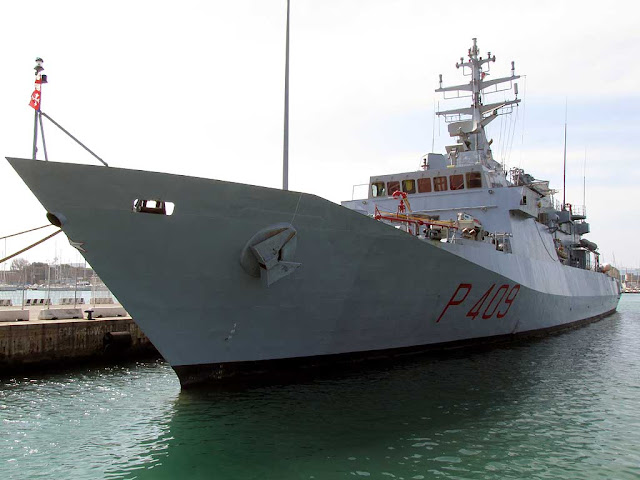 The more recent “Sirio” (P 409) is an offshore patrol vessel, which means her range of action extends beyond the coastal waters. We have already seen another ship of this class, the “Orione” (P 410), in the same occasion last year.
The more recent “Sirio” (P 409) is an offshore patrol vessel, which means her range of action extends beyond the coastal waters. We have already seen another ship of this class, the “Orione” (P 410), in the same occasion last year.See also: A Sphinx and Many Stars
Urania - Chimera - Sirio (Navy site, in Italian)
Sunday, March 27, 2011
In Tuscany
 As many authors writing of Italian journeys around the end of the 19th century, Montgomery Carmichael likes to break with the tradition of the Grand Tour leading the reader off the beaten track with his Tuscan Towns, Tuscan Types and the Tuscan Tongue, published in London in 1901.
As many authors writing of Italian journeys around the end of the 19th century, Montgomery Carmichael likes to break with the tradition of the Grand Tour leading the reader off the beaten track with his Tuscan Towns, Tuscan Types and the Tuscan Tongue, published in London in 1901.The British consular official was more a long time resident than a traveler and he is able, in the first part of the book, to offer us an almost anthropological collection of Tuscan types of the time.
 After a interesting middle section about the many difficulties of the Tuscan dialect, our author chooses five towns to explore the ways and the habits of our cities: Livorno, Lucca, Pisa, Volterra and Portoferraio and the island of Elba.
After a interesting middle section about the many difficulties of the Tuscan dialect, our author chooses five towns to explore the ways and the habits of our cities: Livorno, Lucca, Pisa, Volterra and Portoferraio and the island of Elba.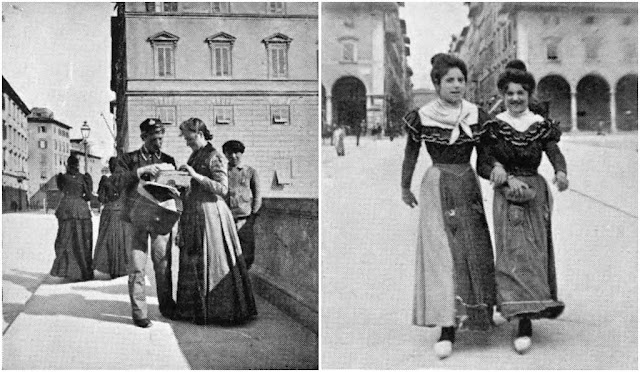 One of the many fascinating features of the chapter about Livorno is a set of photographies, by a Dr. Pietro Rossini, portraying some typical scenes in still easily recognizable places around town.
One of the many fascinating features of the chapter about Livorno is a set of photographies, by a Dr. Pietro Rossini, portraying some typical scenes in still easily recognizable places around town.Carmichael signed off his book in “Livorno la Cara” (Leghorn the Dear) on December 31, 1900.
Original captions of the above photos:
A Levantine Trader - The Majesty of the Law
Water from the public founts - Two Policemen (New Uniform)
What Delays the Letters - Coral Girls
See also: Leghorn “la Cara”
Labels:
Livorno
Saturday, March 26, 2011
Two Tricolor Flags
 The French patrol boat P675 “Arago” at the Capitaneria pier. The ship is flying two different tricolors: her own French flag from the stern and the Italian courtesy flag on the mast.
The French patrol boat P675 “Arago” at the Capitaneria pier. The ship is flying two different tricolors: her own French flag from the stern and the Italian courtesy flag on the mast.The rule that no flag should be flown higher than the national flag does not apply on board a ship: a flag flown at the stern is always in a superior position to a flag flown elsewhere on the ship, even if the latter is higher up. (Flag etiquette, Wikipedia)
Labels:
boat,
Coast Guard,
flag,
Livorno
Friday, March 25, 2011
Unwelcome Barriers
 This bent chained post is part of a line that should separate lanes in “Piazza Cavour”.
This bent chained post is part of a line that should separate lanes in “Piazza Cavour”. A sharp turn after a long straight stretch is always dangerous and these posts know something about it.
A sharp turn after a long straight stretch is always dangerous and these posts know something about it. This concrete bollard in “Piazza Attias” was deliberately knocked over to gain access to some off-limits parking space. Both the posts and the bollard have been like that for months, but nobody seems to care.
This concrete bollard in “Piazza Attias” was deliberately knocked over to gain access to some off-limits parking space. Both the posts and the bollard have been like that for months, but nobody seems to care.See also: Piazza Attias - Ugly Corner - Palazzo Modigliani - Attias
Labels:
Livorno
Thursday, March 24, 2011
Green Light
 The green light at the entrance of the “Porto Mediceo”, from where one can watch and photograph all the passing ships.
The green light at the entrance of the “Porto Mediceo”, from where one can watch and photograph all the passing ships.See also: Norwegian Jade - On Lookout - Voyager of the Seas - Elqui - Pilotina Due - Turning Ships - Bye Bye Vespucci
Labels:
harbor,
light,
lighthouse,
Livorno,
port
Wednesday, March 23, 2011
Reversed Flags
 Livornesi have recently discovered some interest in our national flag, usually displayed only in occasion of the Football World Cup matches. Some of them are so unfamiliar with the device that they often hang it backwards.
Livornesi have recently discovered some interest in our national flag, usually displayed only in occasion of the Football World Cup matches. Some of them are so unfamiliar with the device that they often hang it backwards. The veg stall owner got it right twice, but we can't say the same of who hung the flag from that window.
The veg stall owner got it right twice, but we can't say the same of who hung the flag from that window.See also: One Hundred and Fifty - Tricolor Night
Tuesday, March 22, 2011
Almost Spring
 Two lions guarding a slightly ajar front door in “Via Ricasoli”.
Two lions guarding a slightly ajar front door in “Via Ricasoli”. Same street, a chain of puppet rabbits in a shop window.
Same street, a chain of puppet rabbits in a shop window. Tiles with the symbol of the Agnus Dei (Lamb of God) on a building in “Piazza Attias”. Dona nobis pacem means grant us peace.
Tiles with the symbol of the Agnus Dei (Lamb of God) on a building in “Piazza Attias”. Dona nobis pacem means grant us peace. The grass is full of daisies in “Piazza della Vittoria”; in background the church of “Santa Maria del Soccorso”.
The grass is full of daisies in “Piazza della Vittoria”; in background the church of “Santa Maria del Soccorso”. A wall planter in “Via Borsi” with some not so healthy plants.
A wall planter in “Via Borsi” with some not so healthy plants.More Walks
Monday, March 21, 2011
Hearts
 A pierced heart on a wall in “Via Paoli”.
A pierced heart on a wall in “Via Paoli”. A quite strange wooden hollow heart in “Corso Amedeo”.
A quite strange wooden hollow heart in “Corso Amedeo”. Personalized hearts for sale (35 euro a piece) in “Via de Larderel”.
Personalized hearts for sale (35 euro a piece) in “Via de Larderel”.
Labels:
Livorno
Sunday, March 20, 2011
Federico Caprilli
 Federico Caprilli was born in Livorno in 1868. He is credited with developing the system for “forward seat” riding. When he became a young cadet in the Italian Cavalry horses were still ridden over obstacles in an extremely restricted manner.
Federico Caprilli was born in Livorno in 1868. He is credited with developing the system for “forward seat” riding. When he became a young cadet in the Italian Cavalry horses were still ridden over obstacles in an extremely restricted manner.Riders were taught to pull and lean back during the jump to make sure the horse's hindlegs would land first to minimise the impact, protecting the supposedly fragile forelegs. Caprilli had been watching horses jumping freely, observing that all of them always and naturally landed on their forelegs.
 The new ideas of the young Lieutenant weren't well accepted at first. He was removed from his duties as a trainer of cavalry units and transferred to Southern Italy as a punishment.
The new ideas of the young Lieutenant weren't well accepted at first. He was removed from his duties as a trainer of cavalry units and transferred to Southern Italy as a punishment.Only a few years later the new ideas were recognised and Caprilli was returned to the cavalry schools in Northern Italy where, after a year of his training, the results where ncredible: the horses were so willing that their riders were able to complete a cavalry training course without reins.
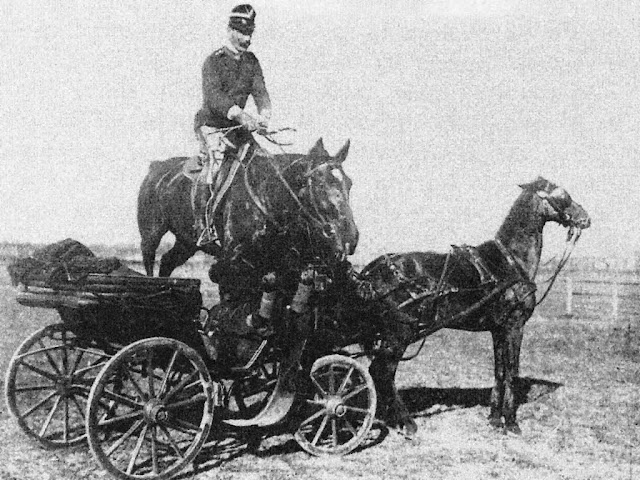 Following this breakthrough, Caprilli was at last made Chief Riding Instructor of the Italian Cavalry. Soldiers from around the world came to his schools to learn his training system, mostly based on the non-interference of the riders.
Following this breakthrough, Caprilli was at last made Chief Riding Instructor of the Italian Cavalry. Soldiers from around the world came to his schools to learn his training system, mostly based on the non-interference of the riders. Our local horse-racing facility, inaugurated in 1894, was renamed in his honor “Ippodromo Federico Caprilli” in 1937. He died in Pinerolo in 1907, when his horse slipped on icy cobblestones and fell. On his tombstone, this simple epitaph:
Our local horse-racing facility, inaugurated in 1894, was renamed in his honor “Ippodromo Federico Caprilli” in 1937. He died in Pinerolo in 1907, when his horse slipped on icy cobblestones and fell. On his tombstone, this simple epitaph:FRIDERICUS CAPRILLI
MAGISTER EQUITUM
1868 - 1907
(Federico Caprilli
Master of Horsemen
1868 - 1907)
MAGISTER EQUITUM
1868 - 1907
(Federico Caprilli
Master of Horsemen
1868 - 1907)
Saturday, March 19, 2011
Fake Windows
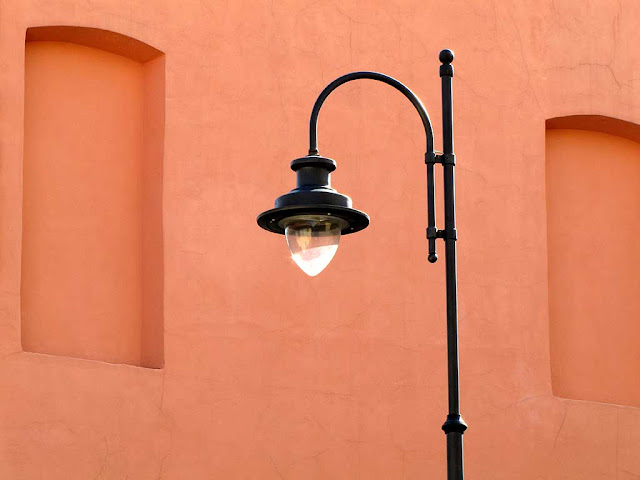 Fake windows and a real lamp post in “Via Strozzi”.
Fake windows and a real lamp post in “Via Strozzi”.See also: Les fenêtres étranges (Versailles Daily Photo)
Friday, March 18, 2011
Tricolor Night
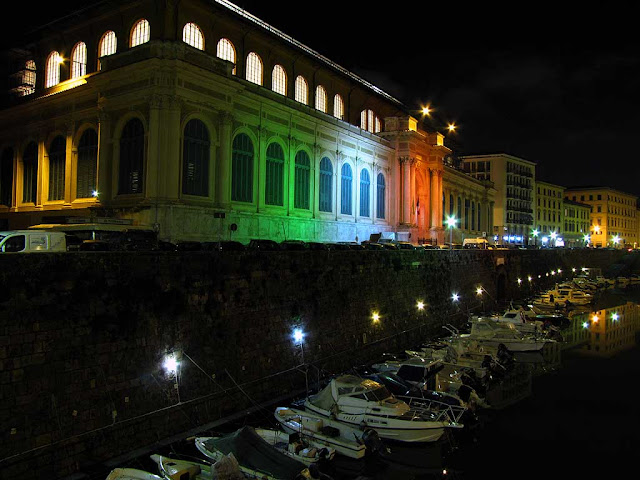 Most of you probably already know how much I like events like the so called White Night or Blue Night. A Tricolor Night became unavoidable and therefore a constellation of minor non-events was organized, or better disorganized, all over the town center.
Most of you probably already know how much I like events like the so called White Night or Blue Night. A Tricolor Night became unavoidable and therefore a constellation of minor non-events was organized, or better disorganized, all over the town center. Ramshackle bands playing improbable music of the Risorgimento, horse riders in even more improbable “garibaldino” attire and the since unattained technical prowess of illuminating our “Mercato Centrale” with three colored floodlights, were some of the pearls of this absolutely forgettable night.
Ramshackle bands playing improbable music of the Risorgimento, horse riders in even more improbable “garibaldino” attire and the since unattained technical prowess of illuminating our “Mercato Centrale” with three colored floodlights, were some of the pearls of this absolutely forgettable night.See also: White Night - Blue Night Walk - Mercato Centrale
Labels:
Livorno,
Mercato Centrale
Thursday, March 17, 2011
One Hundred and Fifty
 Today we commemorate the 150th anniversary of the unification of Italy as a single country in 1861, on March 17. I am not sure there is much to celebrate here (or elsewhere), but the “tricolori”, the Italian flags, are all over the city.
Today we commemorate the 150th anniversary of the unification of Italy as a single country in 1861, on March 17. I am not sure there is much to celebrate here (or elsewhere), but the “tricolori”, the Italian flags, are all over the city. Our National Day is on June 2, the proclamation of the Republic in 1946. In 1861, on March 17, the first Italian Parliament in Turin proclaimed Vittorio Emanuele II King of Italy.
Our National Day is on June 2, the proclamation of the Republic in 1946. In 1861, on March 17, the first Italian Parliament in Turin proclaimed Vittorio Emanuele II King of Italy.So Italy was born... on Saint Patrick's Day!
Labels:
Livorno
Wednesday, March 16, 2011
De Larderel
 Crabs and scallop shells on the main door of “Palazzo de Larderel”, now the Civil Courthouse of Livorno.
Crabs and scallop shells on the main door of “Palazzo de Larderel”, now the Civil Courthouse of Livorno. Still on the front door, the family crest of the de Larderel family.
Still on the front door, the family crest of the de Larderel family.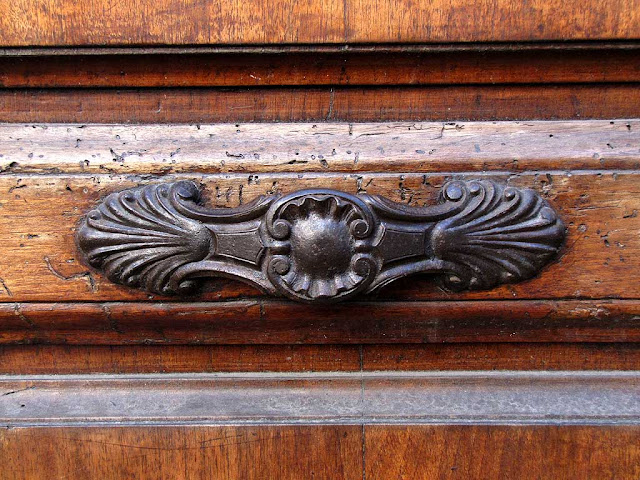 A more modest handle on a secondary door of the same building.
A more modest handle on a secondary door of the same building.See also: Palazzo de Larderel
Labels:
Livorno
Tuesday, March 15, 2011
Mid-March Rain
 A “Madonnina” on the corner of “Via dell'Angiolo”.
A “Madonnina” on the corner of “Via dell'Angiolo”. “Personal” supermarket carts locked in “Piazza Guerrazzi”.
“Personal” supermarket carts locked in “Piazza Guerrazzi”.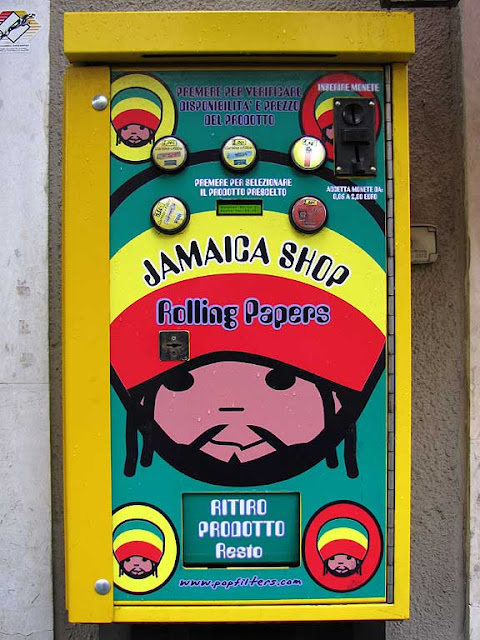 A rolling paper vending machine in “Corso Amedeo”.
A rolling paper vending machine in “Corso Amedeo”. “No trespassing, military zone, armed guards” in “Viale Marconi”.
“No trespassing, military zone, armed guards” in “Viale Marconi”. Fancy bike parking in “Piazza Attias”.
Fancy bike parking in “Piazza Attias”.More Walks
Monday, March 14, 2011
One, Two, Three
Sunday, March 13, 2011
Marie de' Medici

“The Embarkation of Maria de' Medici at Livorno” (modello)
Oil on canvas by Domenico Cresti, called Passignano (1559-1638)
France, private collection
Oil on canvas by Domenico Cresti, called Passignano (1559-1638)
France, private collection
Marie de' Medici (26 April 1575 – 3 July 1642) was queen consort of France, as the second wife of King Henry IV of France, of the Bourbon branch of the kings of France. Following his assassination in 1610, which occurred the day after her coronation, she acted as regent for her son King Louis XIII of France, until he came of age. (Wikipedia)
 On Monday 17 October 1600, Maria de' Medici sailed to Marseille on the French admiral galley “La Réale”, leaving from this jetty of the “Fortezza Vecchia”.
On Monday 17 October 1600, Maria de' Medici sailed to Marseille on the French admiral galley “La Réale”, leaving from this jetty of the “Fortezza Vecchia”.See also: Molo del Soccorso
Labels:
Livorno
Subscribe to:
Posts (Atom)


